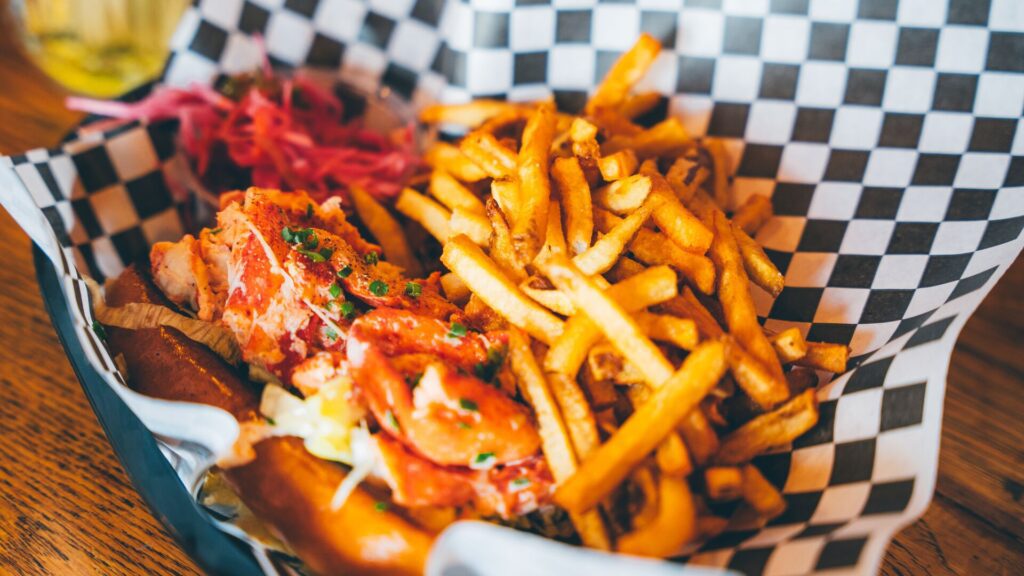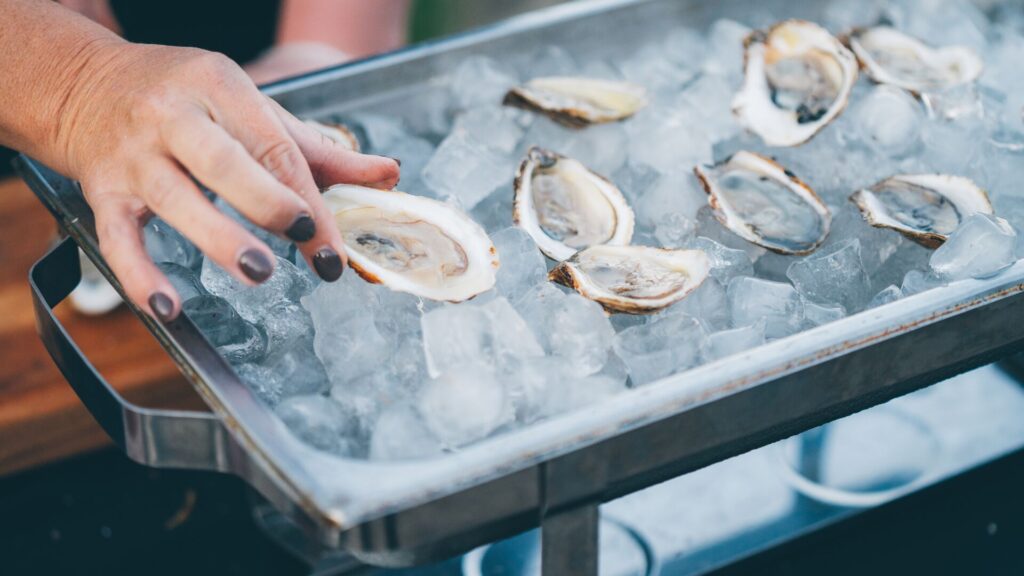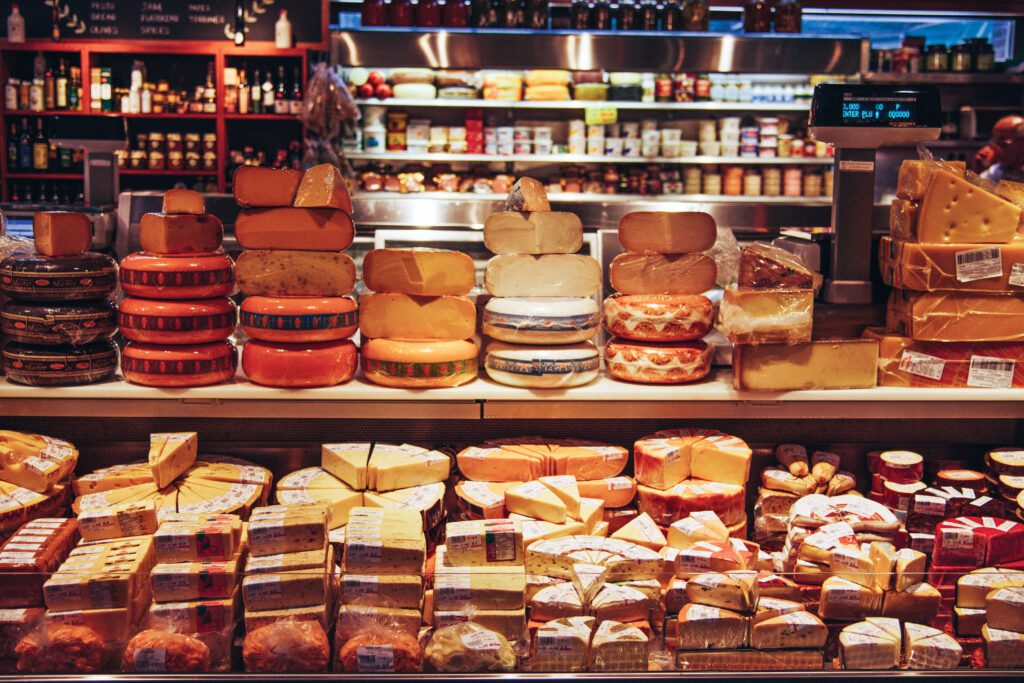From the oyster shacks of Prince Edward Island to the pâtisseries of Montréal, Eastern Canada serves a moreish spread of regional flavours, local traditions, and must-taste specialties. And whether you’re fine dining in the city, grazing your way from one coastal village to the next, or an epicurious traveller tracing the roots of Acadian cuisine, you’ll find memorable bites wherever your tastebuds lead you. So, consider this travel guide your ultimate menu for its tastiest – from cheesy poutine to buttery tourtière, crispy fiddleheads and briny fresh lobster rolls, and the unique culinary experiences that Make Travel Matter.


Eastern Canada’s Culinary Identity
Eastern Canada includes Nova Scotia, New Brunswick, Prince Edward Island, Québec, Newfoundland and Labrador and the eastern part of Ontario, as you’ll see in this map. While each province has its own geography, history and drawcards, together they form a culinary region defined by its overlapping cultures – where various influences have long simmered together to create a multi-layered epicurean scene.
Indigenous Roots
These lands have long been home to the Mi’kmaq, Maliseet, Innu, Algonquin, and Anishinaabe peoples, whose foodways – from smoked eel and bannock to seasonal foraging and maple sap harvesting – continue to shape the region’s culinary landscape. Today you’ll find Indigenous-run restaurants, cultural centres and heritage highlights in places like Kahnawàke near Montréal, Membertou in Cape Breton, and the Petroglyphs of Ontario’s Kawartha Lakes.
French and Acadian Influence
French colonists first arrived in the early 1600s, settling in areas like Québec and Acadia (present-day Nova Scotia and New Brunswick). Their legacy lives on in rich, creamy sauces, tourtière, ragoût, and pâtisseries, while Acadian cooking often blends rustic ingredients with preserved meats and seafood. You’ll also see this heritage reflected in the architecture of Old Québec, the dialects of the Maritimes, and in towns like Caraquet and Clare, where Acadian identity shines on.
British and Irish Heritage
From the 1700s onward, British, Scottish and Irish immigrants arrived in waves. Dishes like Sunday roasts, fish and chips, and butter tarts remain cultural touchstones, especially in places like St John’s, Lunenburg, Kingston and Prince Edward Island. This heritage is also on show in the region’s stone churches, historic pubs and civic buildings, as well as seasonal traditions like St Patrick’s Day – celebrated with pub grub, parades and live music, particularly in Newfoundland and Montréal.
Our extraordinary 10-day Authentic Eastern Canada by Rail holiday will see you savouring Toronto, Montréal and a range of foodie hotspots in between.


Must-Try Dishes by Province
While Eastern Canada’s provinces share culinary themes – from seafood and Indigenous traditions to global influences and hearty classics – each brings its own distinct flavours to the table. Get started with this province-by-province taste of their highlights.
Nova Scotia
Flavours here pay homage to the Atlantic Ocean, with seafood headlining most menus and Digby scallops, prized for their sweetness, standing out as the local delicacy. In the capital, Halifax, donair is the official snack – a local take on a doner kebab with spicy meat and creamy sauce. And rappie pie, a comforting Acadian dish made from grated potatoes and chicken, is typically served with a hearty broth.
New Brunswick
Fredericton, the capital, is surrounded by forests and rivers that feed a cuisine rich in the flavours of both land and sea. Chicken fricot, a hearty stew, is distinctly Acadian; dulse, a salty seaweed snack, speaks to its coastal traditions, while poutines à trou, a fruit-filled pastry, showcases the province’s French-Acadian baking traditions and local produce.
Prince Edward Island
The city of Charlottetown is the epicentre of Canada’s ‘Food Island’. Here, iron-rich red soils here produce some of the country’s finest crops, while the surrounding Gulf of St Lawrence yields world-famous lobsters, oysters and other shellfish – in fact the island’s responsible for 80 per cent of the country’s mussel harvest. Inland, small family farms raise high-quality beef and cultivate apples, blueberries and prized potato varieties such as Russet Burbank, Atlantic, Goldrush, Irish Cobbler and Red Norland.


Newfoundland and Labrador
With St John’s as its capital, Newfoundland and Labrador’s rugged coasts and isolated terrain set the scene for a cuisine grounded in tradition and shaped by necessity. Fish and brewis – a classic dish of salt cod and hard tack (a dense, dry bread once favoured by sailors for its long shelf life) – speaks to the region’s maritime resilience. Jiggs’ dinner, a boiled meal of meat, cabbage, potatoes and split peas, remains a Sunday staple. Meanwhile, flipper pie – made with seal fins – reflects both Indigenous traditions and settler-era survival.
Québec (Eastern Region)
From the capital, Québec City, to the remote coastal borders shared with Newfoundland and Labrador, you’ll taste the French heritage in every bite across this vast province. Must-try dishes include poutine – a cheesy local take on classic chips and gravy – and tourtière, a spicy meat pie traditionally served during the festive season. Fèves au lard, or slow-baked beans with pork, are another hearty staple. And for dessert, maple syrup stars in everything from soft, chewy taffy rolled on snow to the caramel-rich tarte au sucre, or sugar pie.
Ontario
From the urban pulse of Toronto to the lush valleys of Niagara and the lakeside towns beyond, Ontario’s varied landscapes shape an equally diverse food scene. In Toronto, you’ll find a melting pot of global cuisines alongside local icons like the peameal bacon sandwich – a savoury stack of cured pork loin rolled in cornmeal and served on a soft bun. For your sweet tooth, butter tarts are a Canada-wide classic with roots here. Meanwhile, Ontario’s fertile wine regions – particularly in Niagara and Prince Edward County – pour a refreshing lineup of crisp whites, bold reds and lauded ice wines.
Spend 13 memorable days exploring the rugged shores, charming villages and dining highlights of Prince Edward Island and beyond on our Taste of the Maritimes journey.


Iconic Foods of Eastern Canada
Iconic Foods of Eastern Canada
While you’ll no doubt come across a host of stellar bites and sips on your travels, these 12 signature dishes are well worth seeking out.
Lobster Rolls
Best enjoyed on the water’s edge, this Nova Scotia classic features fresh lobster meat, lightly dressed in mayo and lemon and loaded into a buttered, toasted bun.
Poutine
Born in rural Québec in the late 1950s, poutine is a French-Canadian staple of fries, cheese curds and hot gravy – a simple but filling comfort dish served across Eastern Canada.
Tourtière
This meat pie hails from Québec, with roots in French colonial cooking. Typically made from pork, beef or veal and encased in flaky pastry, it’s a festive-season staple in homes and traditional eateries.
Rappie Pie
An Acadian favourite from Nova Scotia, rappie pie combines grated potatoes (with the water pressed out), seasoned broth and meat (usually chicken) which is baked into a golden, starchy casserole.
Ployes
These buckwheat pancakes come from New Brunswick. Cooked only on one side, they’re soft, spongy, and often served with butter, molasses or maple syrup.
Jigg’s Dinner
A Sunday tradition in Newfoundland, Jigg’s dinner features salted (or corned) beef simmered with root vegetables and cabbage in a nod to the region’s Irish heritage and penchant for frugal, filling fare.
Donair (Halifax style)
Named as Halifax’s official dish in 2015, this local take on a doner kebab features spicy beef served in a warm pita, loaded with onions, tomatoes and a signature sweet garlic sauce unique to the East Coast.
Fiddleheads
Harvested along riverbanks in spring, especially in New Brunswick, fiddleheads are the coiled shoots of young ferns. They’re usually boiled or fried, and served with butter or vinegar, with their grassy, asparagus-like flavour making them a forager’s favourite.
Butter Tarts
Ontario’s claim to dessert fame, butter tarts have a flaky crust and a rich, gooey caramel filling of butter, sugar and egg and sometimes raisins.
Nanaimo Bars
Originating in British Columbia but a firm favourite elsewhere, this no-bake treat layers crumbled coconut digestive biscuits with a custard-flavoured icing and chocolate ganache.
Maple Taffy
In Québec’s sugar shacks – especially during the spring – hot maple syrup is poured over fresh snow, then twirled on a stick to form soft, chewy toffee (or taffy, as the locals call it).
Caesar Cocktail
The Caesar mixes vodka with Clamato juice (tomato juice flavoured with clam broth), Worcestershire and hot sauces, as well as spices. It’s a brunch staple and usually garnished with celery, and sometimes, bacon.
Discover where nature and history converge in the homelands of the Maritime Archaic, Viking and Basque peoples on our 13-day Circle Newfoundland & Labrador holiday.


Seasonal Food Experiences
Eastern Canada’s culinary scene moves with the seasons, offering local delicacies and festive traditions throughout the year. Here, three of the region’s most flavour-packed highlights.
Sugar Shack Season
Each spring, as the sap starts to run in Québec’s maple forests, traditional sugar shacks – or cabanes à sucre – open their doors for maple-infused dining experiences. Found mostly across rural Québec, especially in regions like Montérégie and Lanaudière, these rustic eateries serve everything from pea soup and tourtière to maple taffy. Some shacks stick to traditional flavours, while others offer gourmet or plant-based menus, so it’s worth visiting more than one to taste the differences.
Seafood Festivals
Featuring everything from lobster cook-offs to chowder tastings, street eats, and live beats, seafood festivals are a regional fixture from late spring through to early autumn. Nova Scotia’s Lobster Bash (July, Digby) combines food with music and carnival rides; New Brunswick’s Shediac Lobster Festival (July) dates back to 1949, and in Newfoundland, the St John’s Chowder Festival (usually late August) spotlights East Coast flavours. The following month, Prince Edward Island hosts the International Shellfish Festival – Canada’s largest seafood celebration, featuring chef challenges, oyster shucking contests, food stalls, and more.
Winter Comfort Foods
Winter is when Eastern Canada turns out its richest dishes. Québec’s cipaille is a layered meat pie slow-baked for hours, traditionally filled with game like moose, rabbit and partridge. In New Brunswick, chicken fricot – chicken, potato and dumpling stew – is a hearty family favourite, while Nova Scotia’s creamed lobster on toast is a seasonal indulgence. Ontario adds French Canadian baked beans (sweetened with maple) to the list, and in snowy Gaspésie, ragout de pattes – a pork hock stew – is simmered with cloves and cinnamon for extra winter warmth. You’ll find these dishes served everywhere from ski lodges and rustic inns to regional bistros, neighbourhood favourites and cosy inner-city diners.
Experience the magic of Winter in Québec – including its many culinary highlights – on our 12-day adventure from Montréal to the homelands of the Huron-Wendat Nation, and beyond.
Where to Eat: Local Spots and Trails
You’ll create your own path as you eat your way across Eastern Canada, but these standout experiences are well worth a scenic detour.
Lobster Trail (Nova Scotia)
Nova Scotia’s Lobster Trail is a self-guided route connecting more than 45 dining hotspots along the Atlantic coast, including towns like Lunenburg, Digby and Yarmouth. Along the way, you can taste the iconic crustacean in everything from classic lobster rolls to lobster poutine and tacos. The trail is part of a local initiative to Make Travel Matter, encouraging visitors to collect stamps and earn rewards while directly supporting local communities. While there are plenty of standout stops, The Shore Club in Hubbards and Hall’s Harbour Lobster Pound are locally legendary.
Butter Tart Tour (Ontario)
Ontario’s Butter Tart Tour is a tasting trail through the Kawarthas Northumberland region, where you can take your own sweet time exploring more than 30 bakeries and cafes dedicated to the beloved dessert. Including towns such as Peterborough, Lindsay, and Warkworth, each location offers its own unique take on the caramelly treat, ranging from classic recipes to inventive variations with nuts, raisins, and even bacon. Highlights along the trail include Doo Doo’s Bakery in Bailieboro and The Pastry Peddler in Millbrook.
Farmers’ Markets and Food Halls
From coast to countryside, fresh produce emporiums showcase Eastern Canada’s regions and seasons. In Halifax, the Seaport Farmers’ Market, established in 1750, is one of the oldest markets in North America and remains a top spot to taste Nova Scotia’s seafood, jams, and preserves while meeting their makers. Québec City’s Le Grand Marché du Vieux-Port is filled with the aromas of maple syrup and aged cheese, offering a taste of the region’s rich French-Canadian heritage. St John’s Farmers’ Market in Newfoundland has a dynamic mix of wild-caught fish, baked goods, and small-batch preserves. In Charlottetown, Prince Edward Island’s long-running Saturday market showcases its stellar coastal produce, while Toronto’s St Lawrence Market is a buzzing treasure trove of multicultural fare, offering everything from Ukrainian perogis to Nova Scotia smoked salmon. Meanwhile in New Brunswick, the Fredericton Boyce Farmers Market is held on Saturdays, renowned for its handmade pastries, wood-smoked meats, and local crafts. Wherever you venture, these places are an opportunity to literally bite into the farm-to-table ethos that makes Eastern Canada’s food so memorable.
Our 11-day Ontario’s Heartland journey blends cultural and culinary discoveries with outdoor adventures in a customisable holiday designed just for you.


8 Tips for Foodies Visiting Eastern Canada
Get the most out of your Eastern Canada dining experiences with these practical hints.
- Tipping is standard. Around 15-20 per cent of the bill is customary in restaurants, cafés and bars.
- Cash isn’t king. Most places accept debit and credit cards, even in remote areas, but it’s worth carrying change for markets or roadside stands.
- Eat with your hands … sometimes. It’s perfectly acceptable to pick up lobster, shellfish and butter tarts.
- Seafood stock is widely used. Even vegetarian dishes may contain fish-based stocks or sauces, so it’s always worth checking with the restaurant team if you’re concerned.
- Maple taffy and dentures don’t mix. This sweet treat is very chewy and sticky, so proceed with caution.
- BYO rules vary. Some provinces will allow you to bring your own wine, but only at licensed establishments and with a corkage fee.
- Try the local tipples. Sip ice cider in Québec, wild blueberry ale in Nova Scotia, spruce beer in Newfoundland, and cool-climate wines from the vineyards of Ontario, Nova Scotia and Prince Edward Island.
- Learn a few French phrases. French-language menus aren’t always translated, especially in rural Québec. If you’re unsure, bring along a translator app or phrase book, or check with the restaurant’s staff.
